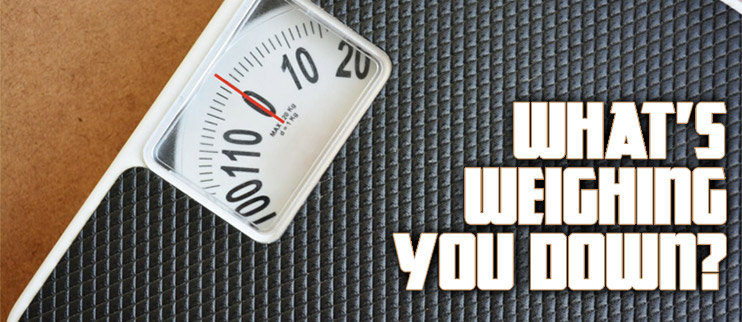
29 Nov Roof Weight: Discover What’s Weighing You Down
Here’s Part 1 of an article addressing something of considerable substance: roof weight. How much do different roofing materials weigh and how does where you live help determine what the weight of your roof should be?
Your Current Roof
It’s important to understand your current roof system. Things you must know go beyond just what type of material it is and how old it is to include the following:
- How many layers of roofing do you have? Keep in mind that, depending on installation, one layer of asphalt shingles can look like two layers at the bottom edge of the roof.
- What is the “base” at the bottom of your roof? Solid decking such as plywood or OSB? Closely fitted dimensional lumber? Spaced-apart lathe boards? In what kind of condition is that material?
The above questions assist in determining how much weight is on your home’s roof now, and also how capable your home is of supporting that weight.
When thinking about your current roof, consider these typical roofing material weights:
Typical Roofing Material Weights Pounds per Square Foot
Aluminum – 0.50 PSF
Painted Steel – 0.80 PSF
Copper – 0.85 PSF
Stone-Coated Steel – 1.25 PSF
Lightweight asphalt shingles – 2.75 PSF
Dimensional fiberglass shingles – 4.5 PSF
Wood shingles – 4.5 PSF
Wood shakes – 6 PSF
Concrete tile – 8-10 PSF
Slate – 10 PSF
Clay tile – 12-20 PSF
Your Home’s Age
While the saying goes that “they don’t build them like they used to,” the reality is that structures weaken with age. Maybe a little moisture infiltration here, a few structural changes there, several punishing storms and wind events, years of thermal cycling…all of those things take a toll on a structure. As a structure ages, it does lose strength. So, the concept of “taking a load off” and reducing the overall pressure on the home through a lower weight roof can be very helpful at restoring and preserving structures that may have been built even as recently as 40 or more years ago.
We remember a roofing contractor of several years ago who promoted low weight roofing with a cartoon image of an elephant dancing on a roof. While comical, it was a reminder that, while an elephant may weigh around 10,000 pounds, an average size home with two layers of asphalt shingles on it may have the equivalent of almost two elephants dancing around on it! That can be a significant burden for a home, regardless of its age.
Your Location and Roof Weight
If you live in an area prone to seismic activity, a low weight roof can help protect your home in the event of an earthquake. In 1995, a devastating earthquake shook Kobe, Japan. It was observed after that event that homes with heavy tile roofs on them often sustained the most severe damage. After that, Classic Metal Roofing Systems started exporting a significant volume of low weight aluminum roofing to Japan so that they could rebuild with lower weight roofs.
Additionally, if you should ever be the unfortunate victim of a home fire, a low weight roofing system can also protect the structure by not caving in, increasing the time firefighters have to put the fire out.
Your Next Roof
As you consider what type of roof is best for your home, one consideration will be whether the old roof needs to be removed, or not. In some cases, based on the type of roof it is and the type of roof you’re installing, it may be necessary to remove the old roof. Also, building codes usually limit the number of layers of roofing to two layers.
As you undertake the calculation of the load on your home, you might want to allow for the fact that many roofing materials lose weight as they age – granules wear off, and oils evaporate. An aged asphalt shingle may weigh 30 – 40% less than it weighed when it was new.
It is not uncommon for metal roofs, with their extremely low weight, to be installed over existing shingle roofs. While we are always happy to consult on individual cases, we generally support that practice and even offer Speed Trims that allow the new roof to accommodate existing drip edges.
While we also sometimes see folks “bend the rules” and install metal over two or even three layers of shingles, we advise great caution before doing that. Even if doing so will not violate a building code, it could end up being a red flag for a home inspector or mortgage company in the future if you decide to sell your home.
The weight of your roof is an important consideration. Low weight roofing can protect a structure in many ways and is well worth considering both for new construction and re-roofing.
